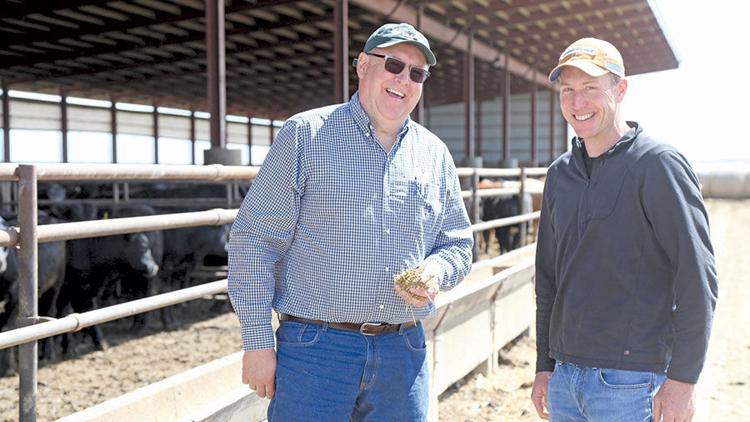
posted on Monday, May 13, 2019 in Vet Services News and Events
AUDUBON, Iowa — Dustin Gleason was just a boy when Bob Blomme started working with his father as their veterinarian.
“He’s been working with us for as long as I can remember,” Gleason says. “You can’t get much better than Bob.”
Blomme works with AMVC Veterinary Services in west central Iowa, and the Gleason family has been one of his clients since he started at the clinic in 1990.
The Gleasons own a share in a sow unit and get weaned pigs and finish them on their Audubon County farm. They also feed cattle in monoslope buildings, and feed Holstein steers in hoop buildings.
With advances in technology, Blomme says he makes fewer on-farm visits than he did 10 years ago. Clients can take photos of animals and email or text them to him for a quick look.
“You can take a look at the photo and describe some differentials to the client,” Blomme says. “Dustin and I talk as needed, probably three or four times a month. We travel so much more than we used to, so it’s difficult to get on the farm as much as we might like.”
The clinic still handles some vaccinations, while many operations handle it on their own.
“They have competent people who are able to perform the vaccinations, while labor is an issue for other operations,” Blomme says.
He meets at least annually with Gleason to discuss his operation’s health program. He may meet monthly or quarterly with other clients.
A good line of communication between veterinarian and client is extremely important, especially when it comes to disease prevention, says Tom Burkgren, executive director of the American Association of Swine Veterinarians.
He says while much of that communication is over the phone, person to person interaction is still invaluable because establishing a level of trust with a new client can be difficult.
“You want to be completely open and transparent on both sides, to help build that comfort level and trust,” he says.
Keeping diseases off the farm through better biosecurity programs has become the norm for most livestock operations, Burkgren says. He says the death loss from porcine epidemic diarrhea (PED) and avian influenza in recent years prompted many producers to limit access to their farms.
It is vital that producers notify their veterinarian as soon as they suspect something is wrong, Burkgren says, especially if the animal is presenting symptoms that are unusual.
The major disease concern at the moment appears to be African swine fever.
“The clinical signs of African swine fever, at the onset, can look like salmonella or PRRS,” Burkgren says. “Veterinarians need to make sure their clients understand it could be something they are not familiar with, and to make sure they are contacted as soon as possible.”
He says veterinarians and livestock groups are pretty effective at educating producers when it comes to recognizing diseases.
“That’s where the communication comes in,” Burkgren says. “We have to get the word out about what might be coming.”
Blomme says cell phones have allowed veterinarians to stay in contact with clients, and that may help with earlier detection of a disease. He says AMVC works with clients and the Iowa Pork Producers Association to update producers on foreign animal diseases.
“The swine industry is small any more compared to what it used to be, so it’s much easier to get the information out,” Blomme says.
Gleason says improving bio-security became a priority four years ago when dysentery spread through the hog operation.
“We had pretty loose biosecurity, and Bob worked with us on developing a 12-month plan to get rid of it,” he says. “We communicated quite a bit, and we were ultimately successful.”
Gleason adds the information is available to producers when it comes to disease prevention.
“Most of the time I don’t have the time to go through all of it, so you have to prioritize what you want to read,” he says. “I think Bob and the clinic do a really good job of making sure we have that information.”
Story credit to: Jeff DeYoung, Iowa Farmer Today, 5/11.
Tags
- amvc veterinarian
- health